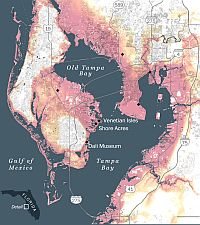
Graphic: Washington Post
Hurricane Irma devasted islands in the Caribbean and did serious damage to cities in Florida. 6.5 million residents of Florida alone lost power and the damage toll is still being calculated across the state. The cities on the West Coast of Florida, particularly those on Tampa Bay, were damaged by high winds and rain but missed the predicted deadly storm surge when Irma jogged slightly eastward.
So far, the Tampa Bay area has been remarkably lucky with hurricanes. One day that luck may run out. When it does, the result won’t be pretty.
By luck, a quirk of geography, or perhaps both, no significant hurricane driven storm surge has hit the Tampa Bay area in almost 100 years. The cities of Tampa, St.Peterburg, and Clearwater are highly vulnerable to catastrophic flooding damage from a storm surge.
Recent studies have identified Tampa as the city most vulnerable to storm surge in the US, ahead of New Orleans. A study by the World Bank called Tampa Bay one of the 10 most at-risk areas on the globe. Fortunately, despite potentially dire projections, the storm surge from Irma in Tampa Bay and much of the rest of the West Coast of Florida was a manageable 2-4 feet.
The last hurricane to directly hit Tampa Bay was a Category 3 storm in 1921, which brought with it a 10-12′ storm surge. Four people died in Tampa and two died in St. Pete in that hurricane. The big difference between then and now is that the population of Tampa and St.Petersburg combined in 1921 was only around 65,000. Today, Tampa-St.Pete is part of a metropolis of almost 4 million people.
One study from 2015 by KCC titled, Most Vulnerable US Cities to Storm Surge Flooding, explained why Tampa Bay is so vulnerable.
There are several reasons why Tampa is the most vulnerable US city to storm surge. First, the continental shelf is relatively wide off the west coast of Florida which means the local bathymetry will accentuate the rise in sea surface from a major hurricane. Second, Tampa Bay creates a large funnel—particularly for a hurricane with its radius of maximum winds near the mouth of the bay. A severe storm with the right track orientation will cause an enormous buildup of water that will become trapped in the bay and inundate large areas of Tampa and St. Petersburg. Fifty percent of the population lives on ground elevations less than ten feet.
CoreLogic, a California-based consultancy, estimates that the Tampa-St. Petersburg-Clearwater metro area has close to 460,000 homes at risk for storm surge with a reconstruction cost value of $80.8 billion.
Over time, Tampa Bay’s vulnerability has grown worse due to the rise of the sea level associated with climate change. Sea levels in Tampa Bay have been rising steadily, averaging an inch or so a decade, and have been rising faster in recent years. By 2100, the National Oceanic and Atmospheric Administration (NOAA) predicts the sea level in Tampa Bay will rise by approximately four feet.
Tampa Bay’s vulnerability to a hurricane driven storm surge has been understood for a long time. Almost a half-century ago, I went to high school in St. Petersburg, FL. I had a girlfriend whose brother was studying meteorology in college. I recall hearing him say that he had learned in his classes that a direct hit by a hurricane in Tampa Bay could send a storm surge of 20 feet into the bay. The figure was scary enough that I remember it after so many decades. Based on much more recent studies, the estimate does not appear to be far off.
In 2010, the Tampa Bay Regional Planning Council commissioned Tampa Bay Catastrophic Plan: PROJECT PHOENIX. Phoenix is a fictional Cat 5 hurricane which takes a direct aim on Tampa Bay. The study was an attempt to develop a worst case scenario. The results predict very scary storm surges.
Storm surge of 11‐16 feet above normal tide levels has completely overtopped barrier islands from Longboat Key to Clearwater Beach. The storm continues to push a massive volume of water into Tampa Bay, and by early afternoon surge levels climb to at least 20 feet above normal at St. Petersburg, 23 feet at Oldsmar,
24 feet at Apollo Beach, and 26 feet above the normal tide level near Downtown Tampa. Storm surge pushes water from the bay up the Hillsborough, Alafia, Lower Manatee, Braden, and Manatee Rivers and the Tampa Bypass Canal, flooding areas well inland.
The Phoenix study estimates that a Cat 5 storm would cut Pinellas County literally in half. Pinellas County, which forms the western shore of Tampa Bay, is home to St.Petersburg and is the most densely populated region in the metropolitan area. The study estimates that almost 2 million people would require medical assistance, with a death toll of over 2,000, more people than died in Hurricane Katrina.
How long will Tampa Bay continue to dodge the bullet? Time will tell.
